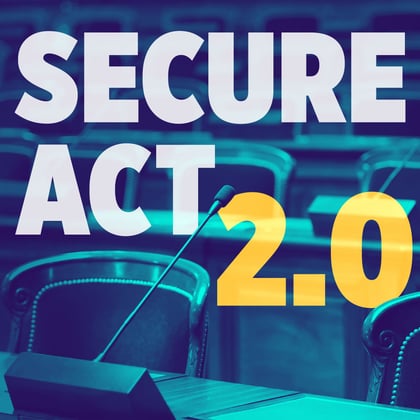What You Need to Know
- The legislation's 92 different provisions include some advantageous changes, and some that will present logistical headaches.
- Provisions effective in 2023 include tax credits for small businesses and financial incentives for employees.
- 2024 will see changes to RMDs, student loan repayments and catch-up contributions.
At year’s end, the Setting Every Community Up for Retirement Enhancement (Secure) 2.0 Act was passed and signed into law, with significant changes to retirement plan rules.
Secure Act 2.0 has an incredible 92 different provisions. The main purpose of this law is to increase employee participation in companies’ retirement plans. It provides incentives to small businesses to create retirement plans and makes automatic enrollment the default for newly hired employees in 2025 (older plans are exempt, which I’ll discuss below). There’s also an automatic contribution escalation feature that would increase an employee’s contribution amount by 1% per year.
Some of these rules provide advantages for businesses launching a retirement plan, and some tweaks will likely present logistical headaches. There are staggered start dates for different provisions, and the below provides an overview of eight of the most impactful changes, in order of their effective dates.
Secure 2.0 Provisions Effective in 2023
1. Tax credits for small businesses to start a retirement plan.
The act provides for a tax credit for companies with 50 or fewer employees for 100% of the startup and annual administration retirement plan costs for the first three years of a plan, up to a maximum of $5,000 a year.
Tax credits can be received for employer contributions that go toward employees. These will match up to $1,000 per employee for employer contributions; they apply only to employees who make less than $100,000. These tax credits are available for the first five years of a new plan.
2. Support for small financial incentives to employees for contributing to a retirement plan.
The act now allows for “de minimis” financial incentives to employees who contribute to the retirement plan. For example, an employer can incentivize new employees to sign up and start contributing to their retirement plans with a gift card.
3. Increased qualified longevity annuity contract (QLAC) maximum.
Current rules allow for up to 25% of a participant’s retirement plan balance, or a maximum of $145,000, to go toward purchasing a qualified longevity annuity contract. The new rule allows for up to $200,000 to be invested in a QLAC.
QLACs are very interesting and probably underutilized as retirement vehicles. You buy into a QLAC with a single premium (for example, a $100,000 purchase), then you decide when you want the deferred annuity to start. The longer you wait, the higher the annual annuity amount you will receive, with a maximum deferral age of 85.
Here’s a potential advantage: Funds invested in a QLAC are not subject to required minimum distribution calculations. This can be beneficial for participants with large retirement balances who don’t expect to need to take large distributions from their retirement plan once they retire.
Secure 2.0 Provisions Effective in 2024
4. Roth 401(k) RMD rule change.
Prior to the Secure 2.0 Act, Roth 401(k) and 403(b) accounts were subject to RMDs, while Roth IRAs were not. This new rule will make Roth 401(k) and 403(b) balances not subject to RMD rules.









 February 22, 2023 at 12:00 PM
February 22, 2023 at 12:00 PM











